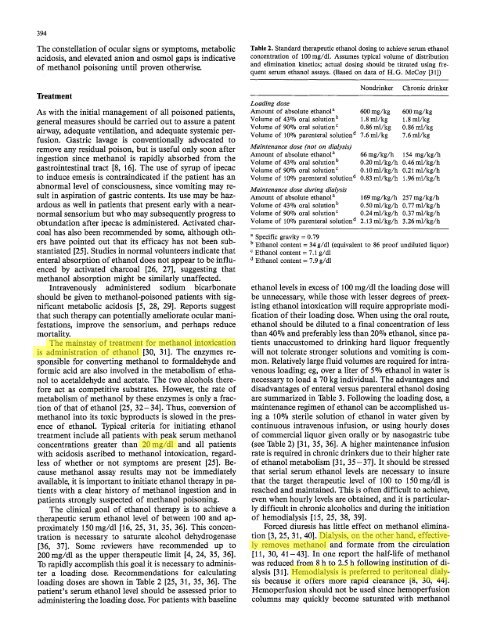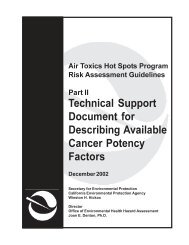Methanol poisoning - While Science Sleeps
Methanol poisoning - While Science Sleeps
Methanol poisoning - While Science Sleeps
You also want an ePaper? Increase the reach of your titles
YUMPU automatically turns print PDFs into web optimized ePapers that Google loves.
394<br />
The constellation of ocular signs or symptoms, metabolic<br />
acidosis, and elevated anion and osmol gaps is indicative<br />
of methanol <strong>poisoning</strong> until proven otherwise.<br />
Treatment<br />
As with the initial management of all poisoned patients,<br />
general measures should be carried out to assure a patent<br />
airway, adequate ventilation, and adequate systemic perfusion.<br />
Gastric lavage is conventionally advocated to<br />
remove any residual poison, but is useful only soon after<br />
ingestion since methanol is rapidly absorbed from the<br />
gastrointestinal tract [8, 16]. The use of syrup of ipecac<br />
to induce emesis is contraindicated if the patient has an<br />
abnormal level of consciousness, since vomiting may result<br />
in aspiration of gastric contents. Its use may be hazardous<br />
as well in patients that present early with a nearnormal<br />
sensorium but who may subsequently progress to<br />
obtundation after ipecac is administered. Activated charcoal<br />
has also been recommended by some, although others<br />
have pointed out that its efficacy has not been substantiated<br />
[25]. Studies in normal volunteers indicate that<br />
enteral absorption of ethanol does not appear to be influenced<br />
by activated charcoal [26, 27], suggesting that<br />
methanol absorption might be similarly unaffected.<br />
Intravenously administered sodium bicarbonate<br />
should be given to methanol-poisoned patients with significant<br />
metabolic acidosis [5, 28, 29]. Reports suggest<br />
that such therapy can potentially ameliorate ocular manifestations,<br />
improve the sensorium, and perhaps reduce<br />
mortality.<br />
The mainstay of treatment for methanol intoxication<br />
is administration of ethanol [30, 31]. The enzymes responsible<br />
for converting methanol to formaldehyde and<br />
formic acid are also involved in the metabolism of ethanol<br />
to acetaldehyde and acetate. The two alcohols therefore<br />
act as competitive substrates. However, the rate of<br />
metabolism of methanol by these enzymes is only a fraction<br />
of that of ethanol [25, 32-34]. Thus, conversion of<br />
methanol into its toxic byproducts is slowed in the presence<br />
of ethanol. Typical criteria for initiating ethanol<br />
treatment include all patients with peak serum methanol<br />
concentrations greater than 20mg/dl and all patients<br />
with acidosis ascribed to methanol intoxication, regardless<br />
of whether or not symptoms are present [25]. Because<br />
methanol assay results may not be immediately<br />
available, it is important to initiate ethanol therapy in patients<br />
with a clear history of methanol ingestion and in<br />
patients strongly suspected of methanol <strong>poisoning</strong>.<br />
The clinical goal of ethanol therapy is to achieve a<br />
therapeutic serum ethanol level of between 100 and approximately<br />
150mg/dl [16, 25, 31, 35, 36]. This concentration<br />
is necessary to saturate alcohol dehydrogenase<br />
[36, 37]. Some reviewers have recommended up to<br />
200 mg/dl as the upper therapeutic limit [4, 24, 35, 36].<br />
To rapidly accomplish this goal it is necessary to administer<br />
a loading dose. Recommendations for calculating<br />
loading doses are shown in Table 2 [25, 31, 35, 36]. The<br />
patient's serum ethanol level should be assessed prior to<br />
administering the loading dose. For patients with baseline<br />
Table 2. Standard therapeutic ethanol dosing to achieve serum ethanol<br />
concentration of 100 mg/dl. Assumes typical volume of distribution<br />
and elimination kinetics; actual dosing should be titrated using frequent<br />
serum ethanol assays. (Based on data of H.G. McCoy [31])<br />
Loading dose<br />
Amount of absolute ethanol a<br />
Volume of 43070 oral solution b<br />
Volume of 90070 oral solntion c<br />
Volume of 10070 parenteral solution d<br />
Maintenance dose (not on dialysis)<br />
Amount of absolute ethanol a<br />
Volume of 4307o oral solution b<br />
Volume of 90070 oral solution c<br />
Volume of 10% parenteral solution d<br />
Maintenance dose during dialysis<br />
Amount of absolute ethanol a<br />
Volume of 43070 oral solution b<br />
Volume of 90% oral solution c<br />
Volume of 10% parenteral solution a<br />
Nondrinker Chronic drinker<br />
600mg/kg<br />
1.8ml/kg<br />
0.86ml/kg<br />
7.6mi/kg<br />
600mg/kg<br />
1.8ml/kg<br />
0.86mt/kg<br />
7.6ml/kg<br />
66mg/kg/h 154mg/kg/h<br />
0.20ml/kg/h 0.46ml/kg/h<br />
0.10ml/kg/h 0;21ml/kg/h<br />
0.83ml/kg/h 1.96rrd/kg/h<br />
169mg/kg/h 257 mg/kg/h<br />
0.50 ml/kg/h 0.77 ml/kg/h<br />
0.24 ml/kg/h 0.37 ml/kg/h<br />
2.13 ml/kg/h 3.26 ml/kg/h<br />
a Specific gravity = 0.79<br />
b Ethanol content = 34 g/dl (equivalent to 86 proof undiluted liquor)<br />
c Ethanol content = 7.1 g/dl<br />
Ethanol content = 7.9 g/dl<br />
ethanol levels in excess of 100 mg/dl the loading dose will<br />
be unnecessary, while those with lesser degrees of preexisting<br />
ethanol intoxication will require appropriate modification<br />
of their loading dose. When using the oral route,<br />
ethanol should be diluted to a final concentration of less<br />
than 400/0 and preferably less than 20% ethanol, since patients<br />
unaccustomed to drinking hard liquor frequently<br />
will not tolerate stronger solutions and vomiting is common.<br />
Relatively large fluid volumes are required for intravenous<br />
loading; eg, over a liter of 5% ethanol in water is<br />
necessary to load a 70 kg individual. The advantages and<br />
disadvantages of enteral versus parenteral ethanol dosing<br />
are summarized in Table 3. Following the loading dose, a<br />
maintenance regimen of ethanol can be accomplished using<br />
a 10% sterile solution of ethanol in water given by<br />
continuous intravenous infusion, or using hourly doses<br />
of commercial liquor given orally or by nasogastric tube<br />
(see Table 2) [31, 35, 36]. A higher maintenance infusion<br />
rate is required in chronic drinkers due to their higher rate<br />
of ethanol metabolism [31, 35 - 37]. It should be stressed<br />
that serial serum ethanol levels are necessary to insure<br />
that the target therapeutic level of 100 to 150mg/dl is<br />
reached and maintained. This is often difficult to achieve,<br />
even when hourly levels are obtained, and it is particularly<br />
difficult in chronic alcoholics and during the initiation<br />
of hemodialysis [15, 25, 38, 39].<br />
Forced diuresis has little effect on methanol elimination<br />
[3, 25, 31, 40]. Dialysis, on the other hand, effectively<br />
removes methanol and formate from the circulation<br />
[11, 30, 41-43]. In one report the half-life of methanol<br />
was reduced from 8 h to 2.5 h following institution of dialysis<br />
[31]. Hemodialysis is preferred to peritoneal dialysis<br />
because it offers more rapid clearance [8, 30, 44].<br />
Hemoperfusion should not be used since hemoperfusion<br />
columns may quickly become saturated with methanol







